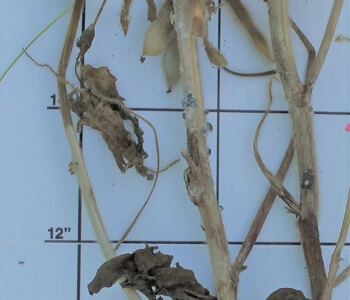ON THE WATCH FOR WHITE MOLD NEXT YEAR
Dec 17, 2019

Your agronomy department is issuing a ‘high alert’ for white mold on soybeans next year. That’s according to Agtegra Agronomy Tech Service Manager Brad Ruden. The reasoning is because of severe outbreaks that were experienced in Brown, Day and Marshall Counties, in South Dakota, and the North Dakota counties of Dickey and Sargent.
While the disease can be an annual threat, this past year’s infestation was “unprecedented,” says Ruden. The following points can help growers best manage for the disease, according to Ruden. “Managing for white mold is a process,” says Ruden. “It takes an integrated approach to planning.”
If you’re in an area with risk, begin by selecting a defensive variety with some level of disease resistance. But keep in mind all lines are susceptible to some extent, with no true resistance. Additionally, consider different rotations, if your white while mold pressure was high. Rotating away from a susceptible crop for more than one season can reduce risk, but this is not always possible.
The next management component is an Agtegra seed treatment additive containing a product called Heads Up®. Research tested for this area, Agtegra’s recommended seed treatment additive proved its effectiveness at reducing white mold infestations. 2019 test plot results showed a 3-4 bushel yield advantage against white mold, while also providing additional broad-spectrum disease control.
Then evaluate plant populations, when seeding. More densely populated canopies increase white mold risk. However, growers must balance maximizing yield with disease threat. Additionally, soybeans planted in wider rows generally have less white mold risk than solid planted soybeans.
Attention to seed and seeding is only part of any white mold plan, however. If and when conditions warrant, foliar fungicides must be considered. Fungicide success is dependent on correct product selection and application timing. Those two items, says Ruden, are the difference between success and failure, when it comes to fungicide treatment.
A little knowledge about the plant and the pathogen helps better understand fungicide timing. The disease only affects soybeans after flowering, following a unique spectrum of environmental conditions. The plants have to be flowering, with a closed canopy, and mild temperatures but moist conditions. That describes much of the Agtegra countryside last July and August.
The disease infects dead flower tissue. As soon as flowering begins, plants become susceptible. But here’s the kicker: fungicides are only preventative. Growers cannot wait until the appearance of the disease before treating, because then it’s too late.
If conditions are favorable for white mold, with flowering, canopy closure and temperatures/moisture, the application needs to be made before the disease strikes. Under heavy white mold pressure, a second application may be necessary upon evaluation at the R2-R3 growth stages.
Agtegra has test plot data for guiding successful and effective fungicide decisions, with timing recommendations. The top performing products consistently show very positive ROIs.
Finally, pull up yield maps and manually mark any fields that experienced high white mold pressure, to facilitate future crop rotation planning.
Working with your agronomist using a multi-stepped approach can help you pro-actively develop a white mold management plan that best fits the conditions of this region.
While the disease can be an annual threat, this past year’s infestation was “unprecedented,” says Ruden. The following points can help growers best manage for the disease, according to Ruden. “Managing for white mold is a process,” says Ruden. “It takes an integrated approach to planning.”
If you’re in an area with risk, begin by selecting a defensive variety with some level of disease resistance. But keep in mind all lines are susceptible to some extent, with no true resistance. Additionally, consider different rotations, if your white while mold pressure was high. Rotating away from a susceptible crop for more than one season can reduce risk, but this is not always possible.
The next management component is an Agtegra seed treatment additive containing a product called Heads Up®. Research tested for this area, Agtegra’s recommended seed treatment additive proved its effectiveness at reducing white mold infestations. 2019 test plot results showed a 3-4 bushel yield advantage against white mold, while also providing additional broad-spectrum disease control.
Then evaluate plant populations, when seeding. More densely populated canopies increase white mold risk. However, growers must balance maximizing yield with disease threat. Additionally, soybeans planted in wider rows generally have less white mold risk than solid planted soybeans.
Attention to seed and seeding is only part of any white mold plan, however. If and when conditions warrant, foliar fungicides must be considered. Fungicide success is dependent on correct product selection and application timing. Those two items, says Ruden, are the difference between success and failure, when it comes to fungicide treatment.
A little knowledge about the plant and the pathogen helps better understand fungicide timing. The disease only affects soybeans after flowering, following a unique spectrum of environmental conditions. The plants have to be flowering, with a closed canopy, and mild temperatures but moist conditions. That describes much of the Agtegra countryside last July and August.
The disease infects dead flower tissue. As soon as flowering begins, plants become susceptible. But here’s the kicker: fungicides are only preventative. Growers cannot wait until the appearance of the disease before treating, because then it’s too late.
If conditions are favorable for white mold, with flowering, canopy closure and temperatures/moisture, the application needs to be made before the disease strikes. Under heavy white mold pressure, a second application may be necessary upon evaluation at the R2-R3 growth stages.
Agtegra has test plot data for guiding successful and effective fungicide decisions, with timing recommendations. The top performing products consistently show very positive ROIs.
Finally, pull up yield maps and manually mark any fields that experienced high white mold pressure, to facilitate future crop rotation planning.
Working with your agronomist using a multi-stepped approach can help you pro-actively develop a white mold management plan that best fits the conditions of this region.